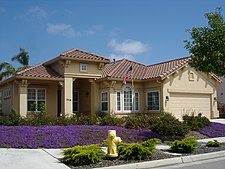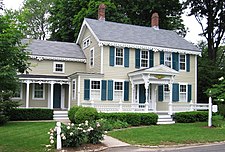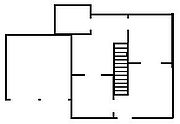
A ranch style house in Salinas, California, United States

Example of an early Victorian "Gingerbread House" in the United States, built in 1855

A Yurt near the Gurvan Saikhan Mountains (in the background); part of Gobi Gurvansaikhan National Park.
A house is a home, shelter, building or structure that is a dwelling or place for habitation by human beings. The term includes many kinds of dwellings ranging from rudimentary huts of nomadic tribes to free standing individual structures.[1] In some contexts, "house" may mean the same as dwelling, residence, home, abode, lodging, accommodation, or housing, among other meanings. The social unit that lives in a house is known as a household. Most commonly, a household is a family unit of some kind, though households can be other social groups, such as single persons, or groups of unrelated individuals. Settled agrarian and industrial societies are composed of household units living permanently in housing of various types, according to a variety of forms of land tenure. English-speaking people generally call any building they routinely occupy "home". Many people leave their houses during the day for work and recreation, and return to them to sleep or for other activities.
History[]
The English word house is derived from the proto-Germanic hud-dos, thought possibly to be a derivative of the verbal root hûd ‘to hide’ (see OED, s.v. house). Terms in other languages show varying derivations.
The oldest house in the world is approximately from 10,000 BC and was made of mammoth bones, found at Mezhirich near Kiev in Ukraine. It was probably covered with mammoth hides. The house was discovered in 1965 by a farmer digging a new basement six feet below the ground.[2]
Architect Norbert Schoenauer, in his book 6,000 Years of Housing, identifies three major categories of types of housing: the "Pre-Urban" house, the "Oriental Urban" house, and the "Occidental Urban" house.
Types of Pre-Urban houses include temporary dwellings such as the Inuit igloo, semi-permanent dwellings such as the pueblo, and permanent dwellings such as the New England homestead.
"Oriental Urban" houses include houses of the ancient Greeks and Romans, and traditional urban houses in China, India, and Islamic cities.
"Occidental Urban" houses include medieval urban houses, the Renaissance town house, and the houses, tenements and apartments of the 19th and 20th centuries. Houses of that time were generally made of simple and raw materials (rocks, sticks, woven cloth, etc.)[1]
Types[]
Structure[]

Wooden chalets in the Swiss Alps, Switzerland.
The developed world in general features three basic types of house that have their own ground-level entry and private open space, and usually on a separately titled parcel of land:
- Single-family detached houses – free-standing on all sides.
- Semi-detached houses (duplexes) – houses that are attached, usually to only one other house via a party wall.
- Terraced house (UK), also known as a row house or townhouse – attached to other houses, possibly in a row, each separated by a party wall.
In addition, there are various forms of attached housing where a number of dwelling units are co-located within the same structure, which share a ground-level entry and may or may not have any private open space, such as apartments (a.k.a. flats) of various scales. Another type of housing is movable, such as houseboats, caravans, and trailer homes.
In the United Kingdom, 27% of the population live in terraced houses and 32% in semi-detached houses, as of 2002. In the United States as of 2000, 61.4% of people live in detached houses and 5.6% in semi-detached houses, 26% in row houses or apartments, and 7% in mobile homes.
Function[]
A Nalukettu traditional Kerala house in India
Some houses transcend the basic functionality of providing "a roof over one's head" or of serving as a family "hearth and home". When a house becomes a display-case for wealth and/or fashion and/or conspicuous consumption, we may speak of a "great house". The residence of a feudal lord or of a ruler may require defensive structures and thus turn into a fort or a castle. The house of a monarch may come to house courtiers and officers as well as the royal family: this sort of house may become a palace. Moreover, in time the lord or monarch may wish to retreat to a more personal or simple space such as a villa, a hunting lodge or a dacha. Compare the popularity of the holiday house or cottage, also known as a crib.
In contrast to a relatively upper class or modern trend to ownership of multiple houses, much of human history shows the importance of multi-purpose houses. Thus the house long served as the traditional place of work (the original cottage industry site or "in-house" small-scale manufacturing workshop) or of commerce (featuring, for example, a ground floor "shop-front" shop or counter or office, with living space above). During the Industrial Revolution there was a separation of manufacturing and banking from the house, though to this day some shopkeepers continue (or have returned) to live "over the shop".
Inside the house[]
Layout[]
Traditional house in southern Brazil.
- Main article: House plan
Ideally, architects of houses design rooms to meet the needs of the people who will live in the house. Such designing, known as "interior design", has become a popular subject in universities. Feng shui, originally a Chinese method of situating houses according to such factors as sunlight and micro-climates, has recently expanded its scope to address the design of interior spaces with a view to promoting harmonious effects on the people living inside the house. Feng shui can also mean the "aura" in or around a dwelling. Compare the real-estate sales concept of "indoor-outdoor flow".
The square footage of a house in the United States reports the area of "living space", excluding the garage and other non-living spaces. The "square metres" figure of a house in Europe reports the area of the walls enclosing the home, and thus includes any attached garage and non-living spaces.[citation needed]
Parts[]

Floor plan of a "foursquare" house
Many houses have several rooms with specialized functions. These may include a living/eating area, a sleeping area, and (if suitable facilities and services exist) washing and lavatory areas. In traditional agriculture-oriented societies, domestic animals such as chickens or larger livestock (like cattle) often share part of the house with human beings. Most conventional modern houses will at least contain a bedroom, bathroom, kitchen (or kitchen area), and a living room. A typical "foursquare house" (as pictured) occurred commonly in the early history of the United States of America where they were mainly built, with a staircase in the center of the house, surrounded by four rooms, and connected to other sections of the house (including in more recent eras a garage).
The names of parts of a house often echo the names of parts of other buildings, but could typically include:
|
Some houses have a pool in the background, or a trampoline, or a playground. |
Construction[]

The structure of the house (under demolition). This house is constructed from bricks and wood and was later covered by insulating panels. The roof construction is also seen.
In the United States, modern house-construction techniques include light-frame construction (in areas with access to supplies of wood) and adobe or sometimes rammed-earth construction (in arid regions with scarce wood-resources). Some areas use brick almost exclusively, and quarried stone has long provided walling. To some extent, aluminum and steel have displaced some traditional building materials. Increasingly popular alternative construction materials include insulating concrete forms (foam forms filled with concrete), structural insulated panels (foam panels faced with oriented strand board or fiber cement), and light-gauge steel framing and heavy-gauge steel framing.

The Saitta House, Dyker Heights, Brooklyn, New York, United States built in 1899 is made of and decorated in wood.[3]
More generally, people often build houses out of the nearest available material, and often tradition and/or culture govern construction-materials, so whole towns, areas, counties or even states/countries may be built out of one main type of material. For example, a large fraction of American houses use wood, while most British and many European houses utilize stone or brick.
In the 1900s, some house designers started using prefabrication. Sears, Roebuck & Co. first marketed their Sears Catalog Homes to the general public in 1908. Prefab techniques became popular after World War II. First small inside rooms framing, then later, whole walls were prefabricated and carried to the construction site. The original impetus was to use the labor force inside a shelter during inclement weather. More recently builders have begun to collaborate with structural engineers who use computers and finite element analysis to design prefabricated steel-framed homes with known resistance to high wind-loads and seismic forces. These newer products provide labor savings, more consistent quality, and possibly accelerated construction processes.
Lesser-used construction methods have gained (or regained) popularity in recent years. Though not in wide use, these methods frequently appeal to homeowners who may become actively involved in the construction process. They include:
- Cannabrick construction
- Cordwood construction
- Geodesic domes
- Straw bale construction
- Wattle and daub

Thermographic comparison of traditional (left) and "passivhaus" (right) buildings
Energy-efficiency[]
In the developed world, energy-conservation has grown in importance in house-design. Housing produces a major proportion of carbon emissions (30% of the total in the UK, for example).[citation needed]
Development of a number of low-energy building types and techniques continues. They include the zero-energy house, the passive solar house, the autonomous buildings, the superinsulated and houses built to the Passivhaus standard.
Earthquake protection[]
One tool of earthquake engineering is base isolation which is increasingly used for earthquake protection. Base isolation is a collection of structural elements of a building that should substantially decouple it from the shaking ground thus protecting the building's integrity[4] and enhancing its seismic performance. This technology, which is a kind of seismic vibration control, can be applied both to a newly designed building and to seismic upgrading of existing structures.[5]
Normally, excavations are made around the building and the building is separated from the foundations. Steel or reinforced concrete beams replace the connections to the foundations, while under these, the isolating pads, or base isolators, replace the material removed. While the base isolation tends to restrict transmission of the ground motion to the building, it also keeps the building positioned properly over the foundation. Careful attention to detail is required where the building interfaces with the ground, especially at entrances, stairways and ramps, to ensure sufficient relative motion of those structural elements.
Legal issues[]
Buildings with historical importance have restrictions.
United Kingdom[]
New houses in the UK are not covered by the Sale of Goods Act. When purchasing a new house the buyer has less legal protection than when buying a new car. New houses in the UK may be covered by a NHBC guarantee but some people feel that it would be more useful to put new houses on the same legal footing as other products.
United States and Canada[]
In the US and Canada, many new houses are built in housing tracts, which provide homeowners a sense of "belonging" and the feeling they have "made the best use" of their money. However, these houses are sometimes built as cheaply and quickly as possible by large builders seeking to maximize profits. Many environmental health issues may be ignored or minimized in the construction of these structures. In one case in Benicia, California, a housing tract was built over an old landfill. Home buyers were never told, and only found out when some began having reactions to high levels of lead and chromium.
Identifying houses[]
With the growth of dense settlement, humans designed ways of identifying houses and/or parcels of land. Individual houses sometimes acquire proper names; and those names may acquire in their turn considerable emotional connotations: see for example the house of Howards End or the castle of Brideshead Revisited. A more systematic and general approach to identifying houses may use various methods of house numbering.
Animal houses[]
Humans often build "houses" for domestic or wild animals, often resembling smaller versions of human domiciles. Familiar animal houses built by humans include bird-houses, hen-houses/chicken-coops and doghouses (kennels); while housed agricultural animals more often live in barns and stables. However, human interest in building houses for animals does not stop at the domestic pet. People build bat-houses, nesting-sites for wild ducks and other birds, bee houses, giraffe houses, kangaroo houses, worm houses, hermit crab houses, as well as shelters for many other animals.
Shelter[]

A modern style house in Canberra, Australia
Forms of (relatively) simple shelter may include:
Houses and symbolism[]
Houses may express the circumstances or opinions of their builders or their inhabitants. Thus a vast and elaborate house may serve as a sign of conspicuous wealth, whereas a low-profile house built of recycled materials may indicate support of energy conservation.
Houses of particular historical significance (former residences of the famous, for example, or even just very old houses) may gain a protected status in town planning as examples of built heritage and/or of streetscape values. Commemorative plaques may mark such structures.
Home ownership provides a common measure of prosperity in economics. Contrast the importance of house-destruction, tent dwelling and house rebuilding in the wake of many natural disasters.
Peter Olshavsky's House for the Dance of Death provides a 'pataphysical variation on the house.
Heraldry[]
The house occurs as a rare charge in heraldry.
See also[]
| Wikimedia Commons has media related to Houses that may be added |
- Institutions
- U.S. Department of Housing and Urban Development
- Regulatory Barriers Clearinghouse
- HUD USER
- Economics
- Affordable housing
- Housing bubble
- United States housing bubble
- Housing tenure
- Functions
- Building science
- Mixed-use development
- Visitability
- Types
- Boarding house
- Earth sheltering
- Home automation
- Housing estate
- Housing in Japan
- Hurricane proof house
- Lodging
- Lustron house
- Mobile home
- Modular home
- Miscellaneous
- Domestic robot
- Housewarming party
- Squatting
- Lists
- List of famous American Houses
- List of house styles
- List of house types
- List of human habitation forms
- List of real estate topics
References[]
- ↑ 1.0 1.1 Schoenauer, Norbert (2000). 6,000 Years of Housing (rev. ed.) (New York: W.W. Norton & Company).
- ↑ Gregorovich, Andrew (1994). "Ancient Inventions of Ukraine". http://www.infoukes.com/history/inventions/.
- ↑ Saitta House - Report Part 1
- ↑ YouTube - Testing of a New Line of Seismic Base Isolators
- ↑ James M. Kelly, Professor Emeritus Civil and Environmental Engineering. "Base Isolation: Origins and Development". National Information Service for Earthquake Engineering, University of California, Berkeley. http://nisee.berkeley.edu/lessons/kelly.html.
External links[]
| Look up house in Wiktionary, the free dictionary. |
- Housing from UCB Libraries GovPubs
This page is being imported from Wikipedia, to create a Wikidwelling stub or article. These steps need to be completed:
The original article was at House. The list of authors can be seen in the history for that page. The text of Wikipedia is available under the CC-BY-SA 3.0 license. |
